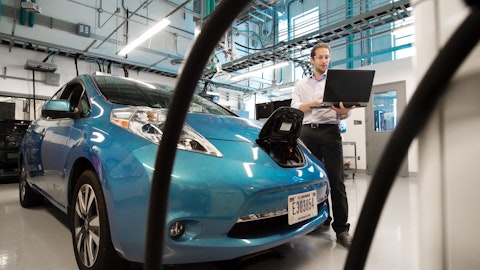Rex Jackson: That’s a good question, one I can’t directly answer, but we have been building backlog, as we have said, at a rapid rate this year. I think the only thing to say is it would be substantially higher, but I just can’t give that out. But anyway, the other thing I was thinking is and listening to the question from James West and how we are handling things, we have supply chain constraints, but our growth rate is fairly astounding. So I think we are banging through this pretty well. And then I would expect from a backlog burn off perspective next year for that to be a nice boost to €“ or maybe a boost or a sustainer of growth rates, right. It will help us get €“ keep the engine running. I don’t know how fast we will burn out, but I don’t see it as being blood-ish.
Matt Summerville: And then to your point, Rex, in your prepared remarks, you called out $7 million in purchase price variance, $3 million in product transition costs. How much of that goes away €“ outright goes away in Q4? How much lingers into Q4? And when will you be 100% €“ when will you be receiving 100% of the benefit from the pricing actions you’ve taken? Will that be in Q4? Will that not be until Q1 of next year? Thank you.
Rex Jackson: Yes. So if you are focused on the price increase, as we said, we’ve got about half of it in Q3, I would expect to get most of it €“ most of the rest in Q4. It’s really dependent on how fast we burn the backlog off and there are different components to backlog and some stuff will ship and some stuff won’t. But I would expect us to be €“ hit 100% by Q1. I’d be surprised if that didn’t happen. And then in terms of the variances and whatnot, as Pat mentioned just a moment ago, the logistics side of the house is turning around pretty well. And I think logistics have pretty well normalized and look a lot like they should going forward. So I would expect a benefit there. As far as the PPV, it’s more isolated. It used to be pretty much across everything, and now it’s more isolated components, and then I would see that coming down nicely over the next couple of quarters.
Can’t forecast when it goes away entirely, but I do think it would be on a downward trajectory, maybe not in Q4 because a lot of things are baked in, but certainly as we go into next year. And then one thing you should know €“ in terms of getting to 100% of price increases, make sure you understand where they apply, they apply mostly to North America €“ hardware in North America. We did a price increase on software earlier last year. And it will €“ if you’re doing a model, it will apply €“ when we get to 100%, it won’t be 100% because we have contracts with major customers that won’t let us do that everywhere. But the impact is certainly a meaningful and positive as we saw in Q3, and we expect to see in Q4.
Matt Summerville: Got it.
Operator: Thank you. We go next now to Bill Peterson of JPMorgan.
Bill Peterson: Yes. Hi, thanks for taking my questions. I guess as we look into next year €“ thanks for the color on how you are prioritizing OpEx. But I guess, what opportunities are you expecting to show the most growth and, thus, where are you trying to prioritize your OpEx? I mean, if you could stack right between things like fleet or commercial work, some of the applications, where are you really focusing the resources as we look into next year?
Pasquale Romano: It’s €“ I mean, we’re continuing to focus in a balanced way across all the verticals, and we will continue to do so. We’re not going to overweight one. We will make the necessary operating expansion on the sales and marketing side as kind of demand dictates essentially by sub-vertical. So it’s just how historically we’ve performed. We haven’t steered it unnaturally in any one given direction. I want to just make sure that we reinforce a point in €“ that I was making in my prepared remarks, in that when we decided to really escalate our spend rate relative to where the market was even before we went public, that was essentially to intersect with the growth models that we have put together for EV installed base effectively.
Where €“ the reason that things have leveled off quite a bit with respect to OpEx expansion, and as Rex mentioned, it doesn’t mean it’s going to go down, it’s just we’re controlling that trajectory now, is because we’ve built out most of the functions substantively necessary to support the verticals and the geographies. There will be continued investments as we flesh things out and as certain verticals unwind from vehicle shortages, but I don’t expect us to unnaturally overweight anything and leave another vertical uncovered. It’s just not how we’ve operated historically.
Bill Peterson: Okay. Thanks for that color. For my second question, I’d like to ask where service attach rates are trending, like where is it today? What has been the trend? Has it sustained as a percentage of installed base? Has it gone up? Obviously, there is a lot of new EV drivers out there and that could also kind of create friction and service networks don’t work properly, but what is your team doing to, I guess, to try to drive that higher as we look ahead?
Pasquale Romano: I just want to clarify that when you are referring to €“ you mean our Assure programs, our…
Bill Peterson: Assure programs, yes.




